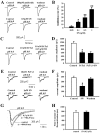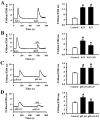Sinomenine protects against ischaemic brain injury: involvement of co-inhibition of acid-sensing ion channel 1a and L-type calcium channels
- PMID: 21585344
- PMCID: PMC3221099
- DOI: 10.1111/j.1476-5381.2011.01487.x
Sinomenine protects against ischaemic brain injury: involvement of co-inhibition of acid-sensing ion channel 1a and L-type calcium channels
Abstract
Background and purpose: Sinomenine (SN), a bioactive alkaloid, has been utilized clinically to treat rheumatoid arthritis in China. Our preliminary experiments indicated that it could protect PC12 cells from oxygen-glucose deprivation-reperfusion (OGD-R), we thus investigated the possible effects of SN on cerebral ischaemia and the related mechanism.
Experimental approach: Middle cerebral artery occlusion in rats was used as an animal model of ischaemic stroke in vivo. The mechanisms of the effects of SN were investigated in vitro using whole-cell patch-clamp recording, calcium imaging in PC12 cells and rat cortical neurons subjected to OGD-R.
Key results: Pretreatment with SN (10 and 30 mg·kg(-1) , i.p.) significantly decreased brain infarction and the overactivation of calcium-mediated events in rats subjected to 2 h ischaemia followed by 24 h reperfusion. Extracellular application of SN inhibited the currents mediated by acid-sensing ion channel 1a and L-type voltage-gated calcium channels, in the rat cultured neurons, in a concentration-dependent manner. These inhibitory effects contribute to the neuroprotection of SN against OGD-R and extracellular acidosis-induced cytotoxicity. More importantly, administration of SN (30 mg·kg(-1) , i.p.) at 1 and 2 h after cerebral ischaemia also decreased brain infarction and improved functional recovery.
Conclusion and implications: SN exerts potent protective effects against ischaemic brain injury when administered before ischaemia or even after the injury. The inhibitory effects of SN on acid-sensing ion channel 1a and L-type calcium channels are involved in this neuroprotection.
© 2011 The Authors. British Journal of Pharmacology © 2011 The British Pharmacological Society.
Figures






Similar articles
-
Tissue kallikrein protects cortical neurons against in vitro ischemia-acidosis/reperfusion-induced injury through the ERK1/2 pathway.Exp Neurol. 2009 Oct;219(2):453-65. doi: 10.1016/j.expneurol.2009.06.021. Epub 2009 Jul 2. Exp Neurol. 2009. PMID: 19576887
-
Failed Neuroprotection of Combined Inhibition of L-Type and ASIC1a Calcium Channels with Nimodipine and Amiloride.Int J Mol Sci. 2020 Nov 24;21(23):8921. doi: 10.3390/ijms21238921. Int J Mol Sci. 2020. PMID: 33255506 Free PMC article.
-
Therapeutic Effect Analysis of Sinomenine on Rat Cerebral Ischemia-Reperfusion Injury.J Stroke Cerebrovasc Dis. 2016 May;25(5):1263-1269. doi: 10.1016/j.jstrokecerebrovasdis.2016.02.023. Epub 2016 Mar 9. J Stroke Cerebrovasc Dis. 2016. PMID: 26971038
-
Translational strategies for neuroprotection in ischemic stroke--focusing on acid-sensing ion channel 1a.Transl Stroke Res. 2014 Feb;5(1):59-68. doi: 10.1007/s12975-013-0319-5. Epub 2014 Jan 5. Transl Stroke Res. 2014. PMID: 24390970 Free PMC article. Review.
-
Neuropsychopharmacological understanding for therapeutic application of morphinans.Arch Pharm Res. 2010 Oct;33(10):1575-87. doi: 10.1007/s12272-010-1009-4. Epub 2010 Oct 30. Arch Pharm Res. 2010. PMID: 21052935 Free PMC article. Review.
Cited by
-
Method parameters' impact on mortality and variability in rat stroke experiments: a meta-analysis.BMC Neurosci. 2013 Apr 1;14:41. doi: 10.1186/1471-2202-14-41. BMC Neurosci. 2013. PMID: 23548160 Free PMC article.
-
Sinomenine activation of Nrf2 signaling prevents inflammation and cerebral injury in a mouse model of ischemic stroke.Exp Ther Med. 2021 Jun;21(6):647. doi: 10.3892/etm.2021.10079. Epub 2021 Apr 18. Exp Ther Med. 2021. PMID: 33968178 Free PMC article.
-
MAPK signaling mediates sinomenine hydrochloride-induced human breast cancer cell death via both reactive oxygen species-dependent and -independent pathways: an in vitro and in vivo study.Cell Death Dis. 2014 Jul 31;5(7):e1356. doi: 10.1038/cddis.2014.321. Cell Death Dis. 2014. PMID: 25077542 Free PMC article.
-
Neuroprotective Phytochemicals in Experimental Ischemic Stroke: Mechanisms and Potential Clinical Applications.Oxid Med Cell Longev. 2021 Apr 28;2021:6687386. doi: 10.1155/2021/6687386. eCollection 2021. Oxid Med Cell Longev. 2021. PMID: 34007405 Free PMC article. Review.
-
Sinomenine inhibits amyloid beta-induced astrocyte activation and protects neurons against indirect toxicity.Mol Brain. 2020 Mar 4;13(1):30. doi: 10.1186/s13041-020-00569-6. Mol Brain. 2020. PMID: 32127013 Free PMC article.
References
Publication types
MeSH terms
Substances
LinkOut - more resources
Full Text Sources

